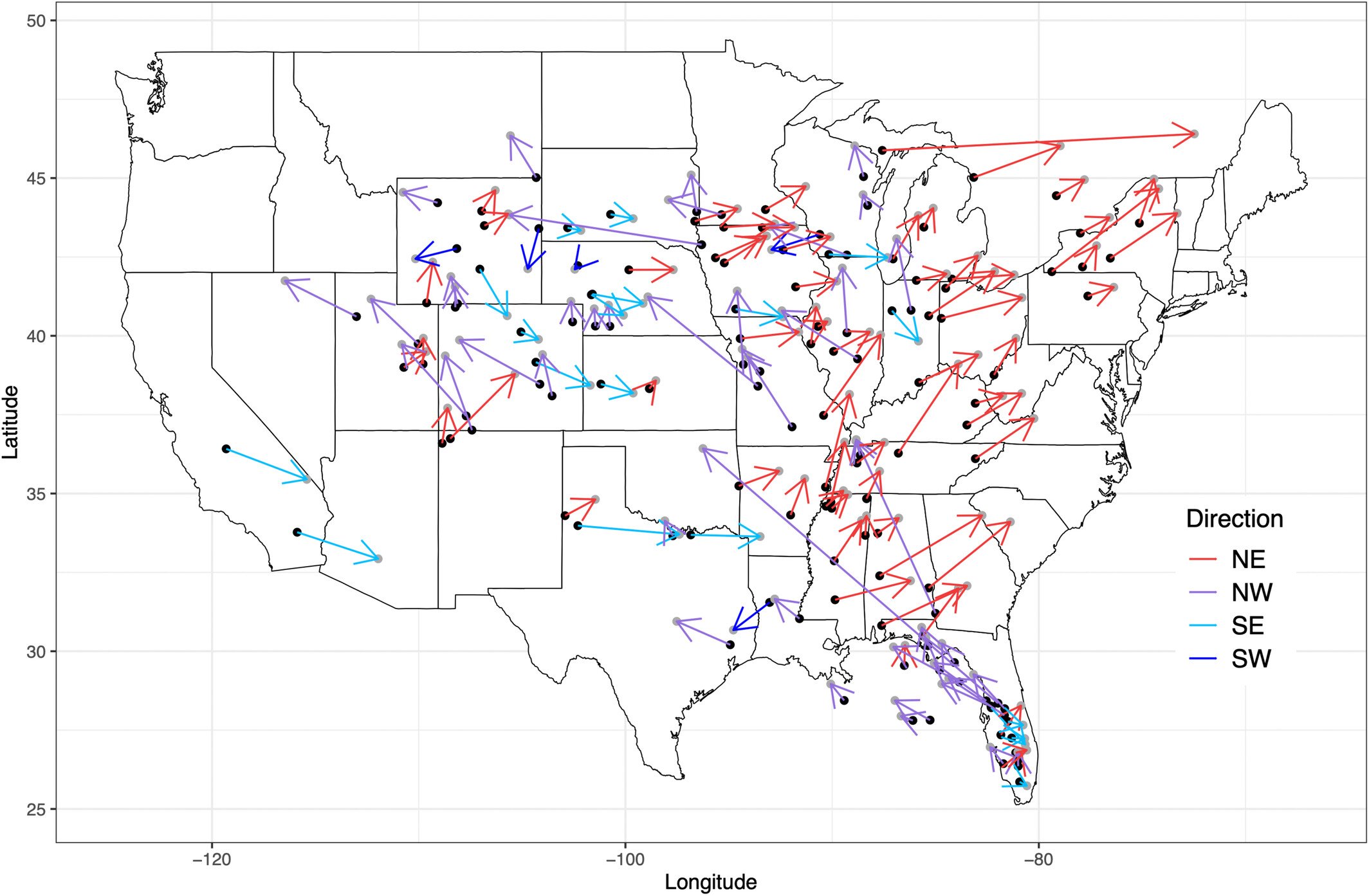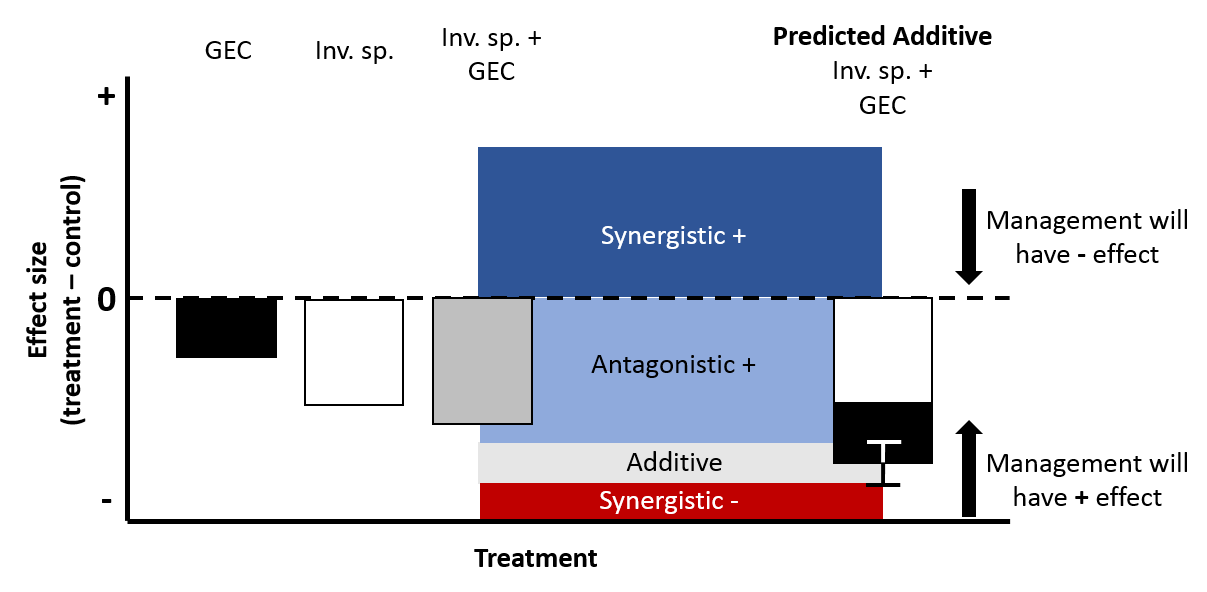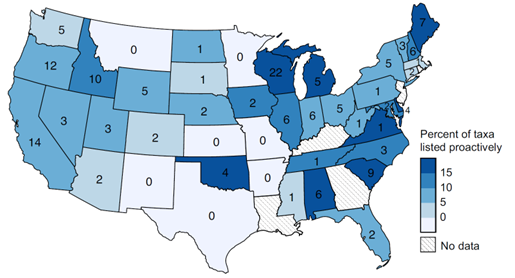Original Research
One goal of NE RISCC is to conduct original research to address priority needs of practitioners. Browse the research projects below to see what the NE RISCC leadership team has been up to. Have suggestions for research that would serve your needs? Let us know!
Identifying new invasive plants in the face of climate change: a focus on sleeper species
Plant sleeper populations are introduced plants that are currently established in an area but are not yet invasive. When these populations are no longer limited by living or non-living factors, such as climate change, these sleeper populations grow and pose risk to becoming an invasive population. With thousands of introduced plant species, this paper helps readers understand how we can better find and prioritize potential sleepers using the Environmental classification for alien taxa framework (EICAT), and climate suitability mapping. After filtering 1795 introduced species in the northeast to 181, we used EICAT and climate suitability for prioritization, and found 18 high priority plant sleeper species
The emerging invasive species and climate-change lexicon
Terminology associated with invasion ecology varies among user groups, often resulting in barriers to communication and potential disagreements on species’ status within an ecosystem. Climate change is expected to induce range shifts and/or changes to impacts for many taxa, further complicating communication around invasion concepts and terminology. This paper uses a framework to outline twelve potential climate change scenarios related to species movement and impacts in a changing climate. It also discusses real-world scenarios and decision tools that can be used to determine whether ambiguity around invasion terminology will have management consequences.
Boundary spanning increases knowledge and action on invasive species in a changing climate
Boundary-spanning activities can help integrate science into management and inform practice by synthesizing and translating research and practitioner knowledge. While boundary-spanning activities could support proactive and research-informed conservation practice, the success of these efforts is rarely evaluated. Our analysis of NE RISCC repeat survey data suggests that NE RISCC's boundary-spanning efforts have increased knowledge about invasive species and climate change, provided useful resources for practitioners, influenced research priorities, and may increase the number of ways that participants incorporate climate change into invasive species management. Collectively, these results suggest that NE RISCC boundary-spanning activities are serving to integrate science into management and inform practice.
Climate-Smart Invasive Species Management for 21st Century Global Change Challenges
This global review provides an overview of the ways climate change and invasive species can interact to impact management plans, methods, and outcomes, and presents options for climate-smart invasive species management to address these impacts. These impacts can be addressed by proactively evaluating and targeting range-shifting invasive species and introductions from novel pathways, building greater flexibility into management schedules to respond to shifting phenological timing and extreme climate events, adjusting treatment approaches to maintain efficacy despite changing conditions, promoting resilient ecosystems through climate-smart restoration, and considering the interactions of climate change and invasive species during decision-making and goal-setting.
Observed and Potential Range Shifts of Native and Nonnative Species with Climate Change
There is broad concern that the range shifts of global flora and fauna will not keep up with climate change, increasing the likelihood of population declines and extinctions. Many populations of nonnative species already have advantages over native species, including widespread human-aided dispersal and release from natural enemies. But do nonnative species also have an advantage with climate change? This paper reviewed observed and potential range shifts for native and nonnative species globally. The study showed that nonnative species are expanding their ranges orders of magnitude faster than native species, reflecting both traits that enable rapid spread and ongoing human-mediated introduction. The paper further shows that nonnative species have large potential ranges and range expansions with climate change, likely due to a combination of widespread introduction and broader climatic tolerances. With faster spread rates and larger potential to persist or expand, nonnative populations have a decided advantage in a changing climate.
High-impact invasive plants expanding into mid-Atlantic states
Range shifting invasive plants are important to identify proactively so that they can be managed in the early stages of invasion (or even prevented from establishing entirely!). This paper performed impact assessments on 104 plants projected to expand into one or more mid-Atlantic states (Delaware, Kentucky, Maryland, New Jersey, Ohio, Pennsylvania, Virginia, and/or West Virginia) by 2050 with climate change and identified 32 priority species with high impacts on ecosystems of economies.
Hot and happy? The future of invasive plant abundance in the eastern U.S.
Before we can proactively manage range-shifting invasive plants, we must first understand which species are likely to shift and where they are likely to go. Spatial modeling is a common approach for predicting where species could move with climate change. However, most spatial models focus on occurrence of species and neglect abundance. For invasive plants, understanding future abundance is critical for predicting potential ecological impact. This paper models climate-driven shifts in the abundance of 144 invasive plants common in the eastern U.S.
We are family: close relatives of invasives species are more likely to be invasive themselves
Risk assessments are an important tool for proactively identifying potential invasive species in the context of climate change. One question that is often asked in invasive plant risk assessments is whether the species being evaluated is closely related to a known invasive species, with the assumption that species related to invasives (i.e. species of the same genus) are more likely to be invasive themselves. This paper tests this assumption, and yup, close relatives of invasive species are more likely to be invasive!
Ornamental invaders are too close for comfort
It is well known that the majority of invasive plants have been introduced through the ornamental plant trade. Optimally, invasive species should not be sold within their invaded range (instead being offered in places where the species is unlikely to have negative impacts). But it is unclear whether this is the case. This study compared the invaded ranges to locations where they are commercially offered for sale for 89 plants. The study found that invasive plants are commonly available for sale within the range that they are invasive, and many ornamental offerings are actively facilitating the range expansion of invasive plants into areas that will be increasingly suitable with climate change.
Guidelines for Climate-Smart Invasive Species Management
Climate change and invasive species pose novel and combined challenges to ecosystem management and ecological restoration. Managers and decision-makers can address these challenges via climate-smart invasive species management, defined as any management strategy or action that considers and aims to reduce the interactive effects of climate change and invasions. Members of NE RISCC have created a set of guidelines for how to consider and incorporate the interactive effects of climate change and invasions at multiple stages of management based on feedback from practitioners via surveys, interviews, conversations, and workshops. The focus of these guidelines is on the areas served by the NE RISCC, but can also serve as a starting point for climate-smart invasive species management efforts in other regions.
Interacting invasion and global environmental change
This meta-analysis demonstrates that the combined effects of invasions and global environmental changes (such as warming, drought, and nitrogen addition) sometimes interact to produce worse than expected outcomes for native systems, but only in about 13% of cases. Typically, invasive species impacts tended to be more consistently detrimental than abiotic global environmental changes, highlighting the importance of invasive species management in the face of global environmental changes.
Invasive species policy must embrace a changing climate
This perspective paper from the RISCC leadership team reinforces the need to incorporate climate change into our thinking and lays out ways to make invasive species policy and management more ‘climate-smart’. In particular, the paper highlights the need for proactive regulation of warm-adapted invasive ornamental plants to stop invasions into cooler climates before they start. Sharing information across borders is critical for proactive regulation and management. We also see a clear need for restoration practices that consider climate change, including sourcing seeds and plants from warmer climates.
High-impact, range-shifting species in the Northeastern US
Invasive plant regulations are inconsistent across state borders and fail to proactively prevent the introduction of species that could become invasive with climate change. However, factors leading to this inconsistent and reactive regulatory landscape are unknown. This paper takes a deeper look at invasive plant risk assessment protocols (i.e. ‘weed risk assessments’) and evaluates invasive species regulatory lists across six Northeast states (Connecticut, Maine, Massachusetts, New Hampshire, New York, and Vermont). To support consistent and proactive risk assessments across Northeast state borders, Bradley et al. provide tables of regulated species, evaluated species, and high-impact, range-shifting species.
Prioritizing range-shifting plants in Northern New England
Invasive species expanding their ranges northward with climate warming will pose a major management challenge to the northeast. Working proactively to identify, monitor, and regulate these species will be most effective for minimizing future ecological and economic impacts. This research identifies high-impact species expanding into Vermont, New Hampshire, and/or Maine. When combined with a other evaluations for New York and southern New England and Mid-Atlantic states, these analyses provide a comprehensive list of priority species for managers and invasive plant councils in the Northeast to consider when evaluating species for proactive regulation.
Regulation of invasive plants needs coordination
US plant regulatory lists are inconsistent across borders and rarely anticipate range shifts from climate change. However, most states regulate at least one plant taxa prior to its introduction, suggesting that a more proactive approach is possible under existing regulations. Coordination across borders is imperative given gaps in regional defenses against invasion and projected invasive plant range shifts under climate change. RISCC is facilitating coordinated efforts among Invasive Plant Councils across the US to better coordinate regulation of invasive plants.
Biotic resistance to invasion is ubiquitous
Using continental scale data of plant surveys collected by the National Park Service, we found that non-native species were less likely to occur in communities with high numbers of native species. Non-native occurrence was generally higher in plant communities closer to human dominated landscapes, in warmer climates, and in communities characterized by herbaceous native species, but in all environments, diverse native communities were less likely to be invaded. Conserving and restoring high numbers of native plant species can therefore reduce the likelihood of non-native species establishment.
Translational Invasion ecology
Connecting research and practice is a challenge within all fields, and invasion ecology is no different. Translational Invasion Ecology provides a framework by which to develop and apply actionable science to one of the world's top environmental challenges. This approach builds from the Translational Ecology paradigm established by Enquist and colleagues in the 2017 Frontiers in Ecology and the Environment special issue, which involves two-way information sharing, decision-focused research, iteration, and commitment to maintaining diverse and engaged partnerships. Ultimately, Translational Invasion Ecology provides a model for other subdisciplines in ecology.
impacts of climate-driven range shifts
As Earth’s climate rapidly changes, species range shifts are considered key to species persistence. However, some range-shifting species will alter community structure and ecosystem processes. By adapting existing invasion risk assessment frameworks, we can identify characteristics shared with high-impact introductions and thus predict potential impacts. There are fundamental differences between introduced and range-shifting species, primarily shared evolutionary histories between range shifters and their new community. Nevertheless, impacts can occur via analogous mechanisms, such as wide dispersal, community disturbance and low biotic resistance. As ranges shift in response to climate change, we have an opportunity to develop plans to facilitate advantageous movements and limit those that are problematic.
Prioritizing range-shifting invasive plants in Southern New England
Prevention of new invasions is a cost-effective way to manage invasive species and is most effective when emerging invaders are identified and prioritized before they arrive. Climate change is projected to bring nearly 100 new invasive plants to the Northeast. However, these plants are likely to have different types of impacts, making some a higher concern than others. In this research, we identified high priority, range-shifting invasive plants coming to southern New York and southern New England. You can also read the ‘Management Challenge’ summary of this research here.
Incorporating climate change into invasive species management: insights from managers
Interactions between invasive species and climate change present new challenges for management. To address these challenges, this study assessed managers’ concerns, barriers to success, and solutions for incorporating climate change into invasive species management, concluding that stronger connections between managers and researchers are needed to address remaining knowledge gaps.
identifying range-shifting invasive plants
All species, including invasives, are expected to shift their geographic ranges in response to climate change. Climate-driven invasive plant range expansion provides an opportunity to be proactive through preventative policy and early detection and rapid response. By constructing models that predict the potential location of species based on their climate affinities, we provide maps that identify areas of potential spread for individual species and identify regions of the United States that are most at risk of accumulating range-shifting invasive plants. Maps of individual species’ future ranges are available from our partner, EDDMapS. We also created a tool that provides a list of invasive plants expected to shift their ranges into a user-specified geographic area.





















